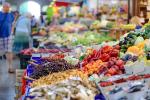H2020 SafeConsumE Project: SafeConsumE: Safer food through consumer behavior change: effective tools and products, communication strategies, education, and a food safety policy that reduces the health burden from foodborne illness.
- Type Project
- Status Filled
- Execution 2017 -2022
- Assigned Budget 9.500.000,00 €
- Scope Europeo
- Main source of financing Horizon 2020
- Project website Proyecto SafeConsumE
Food safety breaches at the consumer level are common, and nearly 40% of foodborne disease outbreaks occur in the home. The overall objective of SafeConsumE is to provide effective, science-based, and sustainable strategies for food authorities, market stakeholders, and the research community to help consumers mitigate risk, thereby reducing the health burden of foodborne diseases in Europe.
SafeconsumE will suggest, develop and evaluate:
- Tools, technologies and products (e.g., sensors, apps, hygiene concepts, kitchen utensils) that promote safe practices.
- Communication strategies that effectively stimulate adoption and market adoption of safer practices and tools/technologies.
- Educational programs that increase skills and knowledge to help teens handle food safely.
- Dynamic, sustainable, and inclusive policy models that stimulate and support initiatives at national and EU levels.
To achieve high implementation and innovation potential, scientists will work with consumers, policymakers, and various market stakeholders using a new transdisciplinary and multi-stakeholder approach based on Theories of Practice combined with design-driven innovation. Addressing the five most significant hazards causing foodborne illnesses, consumer behavior across Europe will be described using a risk-based methodology, leveraging the benefits of high-throughput surveys and a comprehensive qualitative methodology.
New strategies will be developed considering their impact on risk reduction, documented barriers to consumer change, and sustainability. SafeConsumE will drive the transformation toward a healthier and more profitable population by reducing foodborne illnesses, and toward a more sustainable community through food waste reduction and environmentally friendly solutions.
Work performed: Consumer data were collected through observation and interviews with households, students, and teachers, as well as through a household survey covering 10 European countries and over 12,000 individuals. Laboratory experiments were conducted that simulated consumer behavior, mapped the spread of pathogens in kitchens, and analyzed myths. A quantitative microbial risk assessment methodology focused on acute infectious gastroenteritis (AIG) was developed, and the contribution of different risk factors to AIG was calculated. The contribution of different consumption practices to foodborne illness in different regions of Europe was also estimated. An Opportunity Map (OM) was developed that identifies the most important ways to help consumers mitigate risk. Based on the OM, functional specification, and concept evaluation, six product prototypes were developed and evaluated for effectiveness and convenience. Go-to-market strategies for refrigeration appliances were tested in a survey covering five countries. A book of ideas presenting the design concepts developed in the project has been published, and the commercial launch of two kitchen utensils is expected in 2023. Based on country-specific curricula, interviews with teachers and students, and the MO, key learning points for educational programs were defined. Educational resources, including teacher training modules, were developed and evaluated to teach adolescents about food hygiene and safety in six countries. Food safety myths were collected, and an engaging game was developed to reduce them. The game was tested and proven effective in changing food safety beliefs and behaviors. Current communication practices and networks of food safety authorities, non-governmental organizations, and other actors involved in risk assessment, management, and communication within the European food safety system were mapped through online surveys and in-depth interviews. Food safety advice from authorities to consumers was collected and systematized to enable its evaluation.
Good practices for policy models and risk communication were suggested, including how to balance food safety with other sustainability issues. A wide variety of channels and formats were implemented for communicating results. Key findings:
- A series of educational materials to help young people improve and change their behaviors from the moment of purchase to the moment of consumption, adapted (language, culture, and context) for six countries and available on the e-bug website.
- A food safety app that improves food safety beliefs and behaviors, available for Android/Apple phones and computers.
- Key high-impact food safety messages for consumers, available on the project website and presented at two conferences.
- New kitchen appliances and tools to improve food safety and sustainability, two of which will be launched in 2023.
- An ideabook with design concepts for improving food safety is available on the project website.
- Scientific knowledge about European citizens' food handling in relation to risk and their motivation, ability, and opportunity to mitigate risk, disseminated through 50 scientific publications, a risk behavior map, an interactive visualization tool, and numerous conferences.
- Transdisciplinary methodology for studying consumer hygiene and translating research into innovation published in a report and scientific articles.
- Tools for risk communicators were developed: a self-assessment tool and a toolkit with scientifically proven materials published in three reports.
- Policy recommendations on how to balance food security and other sustainability issues published in a scientific article.
The results were disseminated through the website, newsletters, partner websites (e.g., the FoodSafety4EU project), webinars, events for children, adolescents, and university students, social media, at scientific conferences, in scientific articles, in meetings with stakeholders, and through media actors and influencers. Food safety advice based on the scientific results was disseminated by more than 400 media actors worldwide. A summary with links to all resources can be found at safeconsume.eu.
Foodborne illnesses caused by microorganisms represent a significant health and economic burden. The World Health Organization estimates that around 23 million people suffer from foodborne illnesses in Europe each year, and that nearly 40% of foodborne illness outbreaks occur in the home.
The overall objective of SafeConsume was to reduce the burden of foodborne illness in Europe by suggesting and developing strategies to help consumers mitigate risk:
- Tools, technologies, and products that promote safe practices.
- Communication strategies that effectively stimulate the adoption and commercialization of safer practices, tools, and technologies.
- Educational programs that promote skills and knowledge and help adolescents handle food safely.
- Dynamic, sustainable, and inclusive policy models that stimulate and support initiatives at national and EU levels.
Food safety violations at the consumer level are common, with nearly 40% of foodborne outbreaks occurring in the home setting.
The overall objective of SafeConsumE is to provide food authorities, market stakeholders, and the research community with effective, sustainable, and science-based strategies to help consumers mitigate risk, thereby reducing the health burden from foodborne illnesses in Europe. SafeConsumE will suggest, develop, and evaluate:
- Tools, technologies, and products (e.g., sensors, apps, hygiene concepts, kitchen utensils) that encourage safe practices.
- Communication strategies that effectively stimulate the adoption and market acceptance of safer practices and tools/technologies.
- Educational programs that increase skills and knowledge to help teens handle food safely.
- Dynamic, sustainable, and inclusive policy models that stimulate and support initiatives at national and EU levels.
To achieve high implementation and innovation potential, scientists will work with consumers, policymakers, and various market stakeholders under a new transdisciplinary and multi-stakeholder approach based on theories of practice combined with design-led innovation. Covering the five most important hazards causing foodborne illnesses, consumer behavior across Europe will be described using a risk-based methodology, leveraging the strengths of high-throughput surveys alongside an in-depth qualitative methodology. New strategies will be developed taking into account their impact on risk reduction, documented consumer barriers to change, and sustainability. SafeConsumE will support the transformation toward a healthier and more profitable population by reducing foodborne illnesses, and a more sustainable community through less food waste and environmentally friendly solutions.
The following advances beyond the state of the art were achieved:
- Transdisciplinary working models were developed and utilized, providing a platform for future research, innovation, and communication.
- The fieldwork and household survey provide a unique and comprehensive pan-European overview of what people do, know, and believe regarding food safety and the emergence of pathogens in kitchens. This information provides crucial consumer insights for market players, the scientific community, and authorities working with food safety.
- The results of model kitchen laboratory studies and risk analyses showed how consumer practices across Europe contribute to increased risk. These findings can be used to develop more effective food safety messages, educational materials, and tools to keep food safe.
- New methodologies were developed to quantify risk and will form a platform for future risk assessments.
- A major barrier to improving food safety is the lack of tools, for example, for tracking time and temperature. The published intervention opportunities and design concepts are a good starting point for market actors both within and outside the project. Six prototypes of tools and products for home use were developed, and two of them will be launched in 2023.
- Improving young people's knowledge, skills, and motivation to make safe food choices and prepare food is key to future food safety. Educational materials for students and teaching materials with a documented impact on food preparation and storage practices and knowledge have been developed for six countries and launched through the well-established e-Bug program.
- Gamification is a new opportunity to reach consumers. A computer/smartphone game was developed and launched, with a documented impact on food preparation and storage practices for phones and computers.
- The consortium suggested and evaluated new food safety messages. This is expected to inspire food safety authorities to update their consumer messaging, thereby reducing foodborne illnesses.
- Strategies were identified to improve collaboration among stakeholders (NGOs, NGOs, and others) and to achieve a balance between food safety and other sustainability aspects. Tools for risk communicators (a self-assessment tool and a toolkit) were developed that will contribute to better risk communication in the future.
- NOFIMA AS (NOFIMA)







